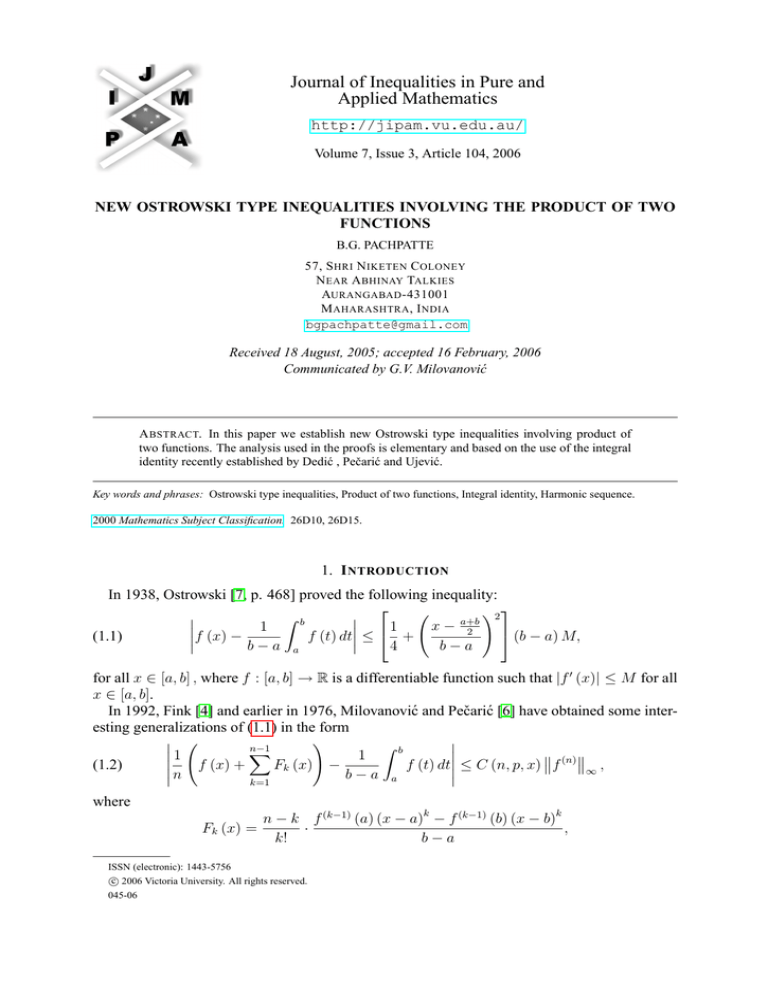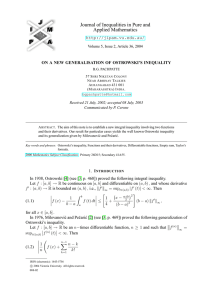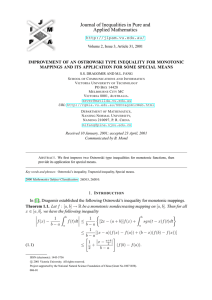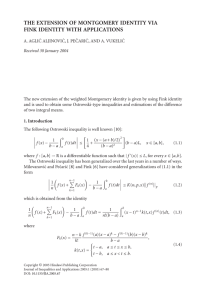
Journal of Inequalities in Pure and
Applied Mathematics
http://jipam.vu.edu.au/
Volume 7, Issue 3, Article 104, 2006
NEW OSTROWSKI TYPE INEQUALITIES INVOLVING THE PRODUCT OF TWO
FUNCTIONS
B.G. PACHPATTE
57, S HRI N IKETEN C OLONEY
N EAR A BHINAY TALKIES
AURANGABAD -431001
M AHARASHTRA , I NDIA
bgpachpatte@gmail.com
Received 18 August, 2005; accepted 16 February, 2006
Communicated by G.V. Milovanović
A BSTRACT. In this paper we establish new Ostrowski type inequalities involving product of
two functions. The analysis used in the proofs is elementary and based on the use of the integral
identity recently established by Dedić , Pečarić and Ujević.
Key words and phrases: Ostrowski type inequalities, Product of two functions, Integral identity, Harmonic sequence.
2000 Mathematics Subject Classification. 26D10, 26D15.
1. I NTRODUCTION
In 1938, Ostrowski [7, p. 468] proved the following inequality:
!2
Z b
a+b
x− 2
1
f (x) − 1
(b − a) M,
(1.1)
f (t) dt ≤ +
b−a a
4
b−a
for all x ∈ [a, b] , where f : [a, b] → R is a differentiable function such that |f 0 (x)| ≤ M for all
x ∈ [a, b].
In 1992, Fink [4] and earlier in 1976, Milovanović and Pečarić [6] have obtained some interesting generalizations of (1.1) in the form
!
Z b
n−1
1
X
1
(1.2)
f
(x)
+
F
(x)
−
f
(t)
dt
≤ C (n, p, x) f (n) ∞ ,
k
n
b−a a
k=1
where
n − k f (k−1) (a) (x − a)k − f (k−1) (b) (x − b)k
Fk (x) =
·
,
k!
b−a
ISSN (electronic): 1443-5756
c 2006 Victoria University. All rights reserved.
045-06
2
as usual
B.G. PACHPATTE
1
p
+
1
p0
= 1 with p0 = 1 for p = ∞, p0 = ∞ for p = 1 and
Z
kf kp =
b
p1
|f (t)|p dt .
a
In fact, Milovanović and Pečarić [6] (see also [7, p. 469]) have proved that
C (n, ∞, x) =
(x − a)n+1 + (b − x)n+1
,
n (n + 1)! (b − a)
while Fink [4] (see also [7, p. 473]) proved that the inequality (1.2) holds provided f (n−1) is
absolutely continuous on [a, b] and f (n) ∈ Lp [a, b] , with
h
i 10
0
0
p
(x − a)np +1 + (b − x)np +1
1
C (n, p, x) =
B ((n − 1) p0 + 1, p0 + 1) p0 ,
n! (b − a)
for 1 < p ≤ ∞, B is the beta function, and
C (n, 1, x) =
(n − 1)n−1
max [(x − a)n , (b − x)n ] .
nn n! (b − a)
Recently, Pachpatte [10] and Dedić, Pečarić and Ujević [3] (see also [2]) have given some
generalizations of Milovanić-Pečarić [6] and Fink [4] inequalities. Motivated by the results in
[10] and [3], in this paper we establish new Ostrowski type inequalities involving the product
of two functions. The analysis used in the proofs is based on the integral identity proved in [3]
and our results provide new estimates on these types of inequalities.
2. S TATEMENT OF R ESULTS
Let (Pn ) be a harmonic sequence of polynomials, that is, Pn0 = Pn−1 , n ≥ 1, P0 = 1.
Furthermore, let I ⊂ R be a segment and h : I → R be such that h(n−1) is absolutely continuous
for some n ≥ 1. We use the notation
"
n−1
X
1
L [h (x)] =
h (x) +
(−1)k Pk (x) h(k) (x)
n
k=1
#
n−1
X
(−1)k (n − k) +
Pk (a) h(k−1) (a) − Pk (b) h(k−1) (b) ,
b
−
a
k=1
to simplify the details of presentation. For n = 1 the above sums are defined to be zero. In a
recent paper [3], Dedić, Pečarić and Ujević proved the following identity (see also [2]):
Z b
Z
1
(−1)n+1 b
(2.1)
L [h (x)] −
h (t) dt =
Pn−1 (t) e (t, x) h(n) (t) dt,
b−a a
n (b − a) a
where
(2.2)
e (t, x) =
t − a if t ∈ [a, x] ,
t − b if t ∈ (x, b] .
k
For the harmonic sequence of polynomials Pk (t) = (t−x)
, k ≥ 0 the identity (2.1) reduces to
k!
the main identity derived by Fink in [4] (see also [3, p. 177]).
Our main results are given in the following theorems.
J. Inequal. Pure and Appl. Math., 7(3) Art. 104, 2006
http://jipam.vu.edu.au/
N EW O STROWSKI
3
TYPE INEQUALITIES
Theorem 2.1. Let (Pn ) be a harmonic sequence of polynomials and f, g : [a, b] → R be
such that f (n−1) , g (n−1) are absolutely continuous for some n ≥ 1 and f (n) , g (n) ∈ Lp [a, b] ,
1 ≤ p ≤ ∞. Then the inequality
(2.3)
Z b
Z b
g (x) L [f (x)] + f (x) L [g (x)] − 1
g
(x)
f
(t)
dt+f
(x)
g
(t)
dt
b−a
a
a
h
i
≤ D (n, p, x) |g (x)| f (n) p + |f (x)| g (n) p ,
holds for all x ∈ [a, b], where
(2.4)
D (n, p, x) =
1
kPn−1 e (·, x)kp0 ,
n (b − a)
e(t, x) is given by (2.2) and p, p0 are as explained in Section 1.
Theorem 2.2. Let (Pn ), f, g, f (n) , g (n) and p be as in Theorem 2.1. Then the inequality
(2.5)
Z b
Z b
1
L [f (x)] L [g (x)] −
L [g (x)]
f (t) dt+L [f (x)]
g (t) dt
b−a
a
a
Z b
Z b
1
1
+
f (t) dt
g (t) dt b−a a
b−a a
≤ {D (n, p, x)}2 f (n) p g (n) p ,
holds for all x ∈ [a, b], where D(n, p, x) and p0 are as in Theorem 2.1.
Remark 2.3. If we take g(t) = 1 and hence g (n−1) (t) = 0 for n ≥ 2 in Theorem 2.1, then
we get a variant of the Ostrowski type inequality given by Dedić, Pečarić and Ujević in [3, p.
180]. We note that the inequality established in Theorem 2.2 is similar to the inequality given
by Pachpatte in [9, Theorem 2].
3. P ROOFS OF T HEOREMS 2.1
AND
2.2
Proof of Theorem 2.1. From the hypotheses we have the following identities (see [3, p. 176]):
Z b
Z
1
(−1)n−1 b
(3.1)
L [f (x)] −
f (t) dt =
Pn−1 (t) e (t, x) f (n) (t) dt
b−a a
n (b − a) a
and
(3.2)
1
L [g (x)] −
b−a
Z
a
b
(−1)n−1
g (t) dt =
n (b − a)
Z
b
Pn−1 (t) e (t, x) g (n) (t) dt.
a
Multiplying (3.1) and (3.2) by g(x) and f (x) respectively and adding the resulting identities we
have
Z b
Z b
1
(3.3) g (x) L [f (x)] + f (x) L [g (x)] −
g (x)
f (t) dt + f (x)
g (t) dt
b−a
a
a
Z b
Z b
(−1)n−1
(n)
(n)
=
g (x)
Pn−1 (t) e (t, x) f (t) dt + f (x)
Pn−1 (t) e (t, x) g (t) dt .
n (b − a)
a
a
J. Inequal. Pure and Appl. Math., 7(3) Art. 104, 2006
http://jipam.vu.edu.au/
4
B.G. PACHPATTE
From (3.3) and using the properties of modulus and Hölder’s integral inequality we have
Z b
Z b
1
g (x) L [f (x)] + f (x) L [g (x)] −
g (x)
f (t) dt + f (x)
g (t) dt b−a
a
a
Z b
Z b
1
(n)
(n)
≤
|g (x)|
Pn−1 (t) e (t, x) f (t) dt + |f (x)|
Pn−1 (t) e (t, x) g (t) dt
n (b − a)
a
a
"
p1
Z b
p10 Z b
(n) p
1
p0
f (t) dt
≤
|g (x)|
|Pn−1 (t) e (t, x)| dt
n (b − a)
a
a
Z b
p10 Z b
p1 #
0
p
g (n) (t) dt
+ |f (x)|
|Pn−1 (t) e (t, x)|p dt
a
a
h
i
= D (n, p, x) |g (x)| f (n) p + |f (x)| g (n) p .
The proof of Theorem 2.1 is complete.
Proof of Theorem 2.2. Multiplying the left sides and the right sides of (3.1) and (3.2) we get
Z b
Z b
1
(3.4) L [f (x)] L [g (x)] −
L [g (x)]
f (t) dt + L [f (x)]
g (t) dt
b−a
a
a
Z b
Z b
1
1
+
f (t) dt
g (t) dt
b−a a
b−a a
Z b
(−1)2n−2
(n)
=
Pn−1 (t) e (t, x) f (t) dt
n2 (b − a)2
a
Z b
(n)
×
Pn−1 (t) e (t, x) g (t) dt .
a
From (3.4) and following the proof of Theorem 2.1 given above with suitable modifications, we
get the required inequality in (2.4). The proof of Theorem 2.2 is complete.
Remark 3.1. Dividing both sides of (3.3) and (3.4) by (b − a) and integrating the resulting
identities with respect to x over [a, b], then using the properties of modulus and Hölder’s integral
inequality, we get the following inequalities
(3.5)
Z b
1
[g (x) L [f (x)] + f (x) L [g (x)]]dx
b − a
a
Z b
Z b
1
1
−2
f (t) dt
g (t) dt b−a a
b−a a
Z b
h
i
1
≤
D (n, p, x) |g (x)| f (n) p + |f (x)| g (n) p dx,
b−a a
J. Inequal. Pure and Appl. Math., 7(3) Art. 104, 2006
http://jipam.vu.edu.au/
N EW O STROWSKI
TYPE INEQUALITIES
5
and
Z b
1
(3.6) L [f (x)] L [g (x)]dx
b−a a
Z b
Z b
1
1
−
L [f (x)] dx
g (x) dx
b−a a
b−a a
Z b
Z b
1
1
+
L [g (x)] dx
f (x) dx
b−a a
b−a a
Z b
Z b
1
1
+
f (x) dx
g (x) dx b−a a
b−a a
Z b
1 (n) (n) f
g
{D (n, p, x)}2 dx.
≤
p
p
b−a
a
We note that the inequalities obtained in (3.5) and (3.6) are respectively similar to the well
known Grüss [5] and Čebyšev [1] inequalities (see also [8]) and we believe that these inequalities are new to the literature.
R EFERENCES
[1] P.L. ČEBYŠEV, Sur les expressions approximatives des intégrales définies par les aures prises entre
les mêmes limites, Proc. Math. Soc. Charkov, 2 (1882), 93–98.
[2] Lj. DEDIĆ, M. MATIĆ AND J. PEČARIĆ, On some generalizations of Ostrowski inequality for
Lipschitz functions and functions of bounded variation, Math. Inequal. Appl., 3(1) (2000), 1–14.
[3] Lj. DEDIĆ, J. PEČARIĆ AND N. UJEVIĆ, On generalizations of Ostrowski inequality and some
related results, Czechoslovak Math. J., 53(128) (2003), 173–189.
[4] A.M. FINK, Bounds of the deviation of a function from its avarages, Czechoslovak Math. J.,
42(117) (1992), 289–310.
Rb
1
[5] G. GRÜSS, Über das maximum des absoluten Betraages von b−a
a f (x) g (x) dx −
Rb
Rb
1
f (x) dx a g (x) dx, Math. Z., 39 (1935), 215–226.
(b−a)2 a
[6] G.V. MILOVANOVIĆ AND J.E. PEČARIĆ, On generalizations of the inequality of A. Ostrowski
and related applications, Univ. Beograd. Publ. Elektrotehn. Fak., Ser. Mat. Fiz., No. 544-576 (1976),
155–158.
[7] D.S. MITRINOVIĆ, J. PEČARIĆ AND A.M. FINK, Inequalities Involving Functions and their
Integrals and Derivatives, Kluwer Academic Publishers, Dordrecht, 1991.
[8] D.S. MITRINOVIĆ, J. PEČARIĆ AND A.M. FINK, Classical and New Inequalities in Analysis,
Kluwer Academic Publishers, Dordrecht, 1993.
[9] B.G. PACHPATTE, New integral inequalities for differentiable functions, Tamkang J. Math., 34(3)
(2003), 249–253.
[10] B.G. PACHPATTE, On a new generalization of Ostrowski’s inequality, J. Inequal. Pure and Appl.
Math., 5(2) (2004), Art. 36. [ONLINE: http://jipam.vu.edu.au/article.php?sid=
378]
J. Inequal. Pure and Appl. Math., 7(3) Art. 104, 2006
http://jipam.vu.edu.au/







